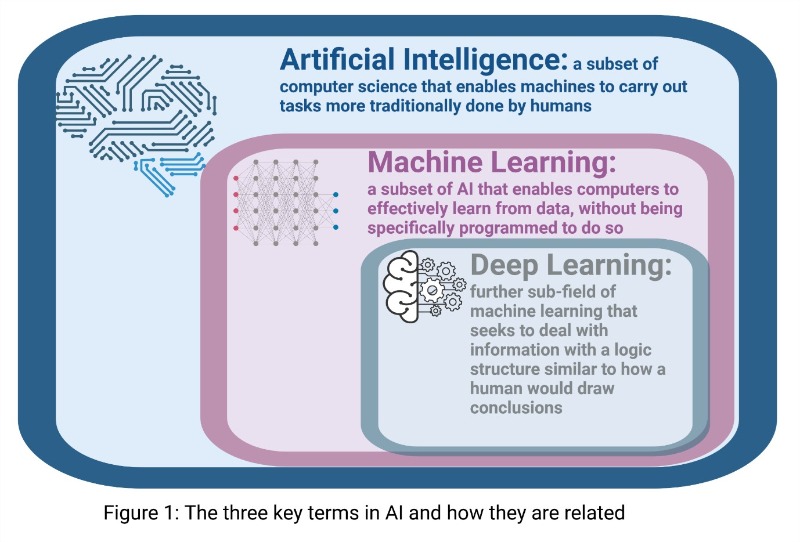Researchers are increasingly turning to artificial intelligence in biology to address complex problems. However, as an emerging concept and tool, the application of artificial intelligence (AI) in your biology research can be challenging to grasp.
That’s why I’ve pulled together a gentle introduction to AI, its sub-methods, machine learning, and deep learning and how they can enhance your data analysis, simplify your image processing, predict your protein structures, and more!
I’ve also highlighted some resources you may find helpful if you want to learn more about these topics.
Why Should Researchers Care About Artificial Intelligence?
In big data, problems are getting harder to solve due to the enormity of the data that needs processing—AI helps with this! Also, researchers can focus on the bigger picture rather than analyzing hundreds or thousands of individual images or data. In a research world of less funding and more competition, AI can be vital to staying ahead of the game.
What is Artificial Intelligence?
AI is a subset of computer science that enables machines to carry out tasks traditionally done by humans. It is an over-arching term that includes two subsets: machine learning and deep learning. Figure 1 summarizes how these subsets relate.

Machine Learning
Machine learning enables computers to learn from data effectively without being specifically programmed. In machine learning, algorithms are ‘trained’ to build a model based on sample data, enabling them to make subsequent predictions or decisions. [1]
Deep Learning
Deep learning is a further subset of machine learning that seeks to mimic the way humans handle information and draw conclusions using a ‘neural network’. Deep learning methods build on work done on artificial neurons developed as an idea back in the 1940s to model real biological brains. [2]
There is increasingly widespread interest in AI, partly because of a combination of new methods and powerful computers becoming more widely accessible. Furthermore, these machine and deep learning technologies play increasingly prominent roles in our day-to-day activities; consider Siri, Spotify, and YouTube.
The accumulation of vast data collections combined with increased investments in AI means that there has been no better time to understand and learn what AI is doing for researchers and what it could do for you!
Applications of Artificial Intelligence in Biology
We already use AI in multiple, wide-ranging fields in biology, from image analysis in microscopy to protein structure prediction and drug discovery.
The increasing prevalence of AI in biology is evident when you review the number of search results on PubMed for the terms ‘AI’, ‘machine learning’, and ‘deep learning’. (Figure 2) The number of results for these terms has increased massively in recent years, a trend that shows no sign of slowing down!

Many recent reviews address the uses of AI in biology in much greater breadth and detail. [3] [4] Three examples are covered here:
Artificial Intelligence in Image Analysis
Biology can be complicated and messy. When it comes to image analysis, researchers face many issues, including:
- the heterogeneity of the samples;
- achieving consistency in analysis, which is challenging due to human error;
- requiring complex tasks to be performed; and
- large amounts of data making analysis time consuming.
However, AI is helping to make handling these issues easier and quicker. One example of this is Aivia from Leica Microsystems.
Aivia uses machine learning to classify objects and pixels in an image, and deep learning to restore and increase image resolution. Here, AI enables you to easily extract essential insights from large and complex images. If you’re interested in learning how to speed up and simplify image analysis watch a recent webinar about Aivia.
Another example of where AI is successfully applied is in analyzing images in infectious disease diagnosis. While skilled microbiologists or pathologists have typically performed this kind of work, they are not immune to human error.
A recent review highlighted the state of the field so far. [5] It concluded that AI has considerable potential to speed up these diagnoses, which in turn should increase timely and accurate diagnoses—which would be hugely beneficial to patient outcomes. [5]
Using Artificial Intelligence to Predict Protein Structure
Another recent development in AI in biology concerns predicting protein structures based on amino acid sequence, known as AlphaFold. [6] AlphaFold is a revolutionary use of AI that accurately predicts protein structure down to an atomic level, even when no homologous protein structures exist.
It does this by employing a ‘neural network’ to combine knowledge of the physical and biological properties of protein structure while using multi-sequence alignments in the design of the deep learning algorithm.
Understanding the structure of all proteins has the capacity to revolutionize all areas of biology, ranging from understanding diseases to comprehending the enzymes involved in the evolution of life as we know it.
As AlphaFold is a relative newcomer to the field, its full implications are not yet fully understood, but they are likely to be far-reaching and long-lasting.
Furthermore, the software is available for researchers to use. So, if you are working on a protein in the lab whose structure is unknown, why not discover its predicted structure using AlphaFold. Who knows what it may uncover?
Artificial Intelligence in Drug Discovery
Traditionally, drug discovery has involved complicated and time-consuming screens to identify potential compounds within a library that give the desired effect, such as killing bacterial cells in the case of an antibiotic.
However, the large size and complexity of the libraries used to screen for new drug candidates make it difficult for individual researchers or labs to do this themselves. But AI and machine learning can help.
There are three key areas where AI is useful in drug discovery:
- AI can be used to predict the properties of a potential compound accurately. The benefits are clear; neither time nor money is wasted on compounds that are unlikely to have the desired effects.
- AI can help develop new compounds by creating molecules with properties predicted for success, which could dramatically improve the discovery and development of effective new drugs.
- Employing AI in the drug discovery process can eliminate repetitive tasks when assessing a drug’s effectiveness. [7]
AI has helped develop a novel anti-cancer drug, an A2 receptor antagonist designed to help T cells attack cancers. [8]
Here, researchers utilized an AI-aided drug discovery program that can computationally sort through, compare and rank many compounds. This approach narrowed down potential candidates for clinical trials from many millions of starting compounds, until this potentially exciting new cancer drug was found.
Can a Biologist Learn Artificial Intelligence?
So, after getting this far, it seems likely you think AI might have a potential role in your research. Perhaps you wonder, “Can I learn these fantastic new techniques to help simplify and accelerate my work?” The answer is a definite yes!
Artificial Intelligence Resources for Biologists
There are multiple (some are even free!) online courses that can get you started in AI:
- Fast AI: Making neural nets uncool again
- Deep Learning: Build deep learning models today
- Deep learning specialization: Become a deep learning expert
Artificial Intelligence in Biology for Researchers Summarized
I hope this article has given you a taste of what AI is currently providing for researchers and how to get started using it in your work. Hopefully, this easy intro has given you a taste of what AI, machine learning, and deep learning are and how they can enhance your data analysis, simplify your image processing, predict your protein structures, and more.
It is interesting to speculate what the next applications of AI in biology may be. But whatever they are, I think they are likely to be incredibly exciting and groundbreaking!
Have you used any AI applications in biology? Let us know in the comments.
References
- Camacho DM et al. (2018) Next-Generation Machine Learning for Biological Networks. Cell 173:1581–1592.
- Ching T et al. (2018) Opportunities and obstacles for deep learning in biology and medicine. Journal of The Royal Society Interface 15:20170387.
- Hassoun S et al. (2022) Artificial Intelligence for Biology. Integr. Comp. Biol. 61:2267-2275.
- Xu Y et al. (2021) Artificial intelligence: A powerful paradigm for scientific research. Innovation (N Y) 2:100179.
- Smith KP (2020) Image analysis and artificial intelligence in infectious disease diagnostics. Clinical Microbiology and Infection 26:1318–1323.
- Jumper J et al. (2021) Highly accurate protein structure prediction with AlphaFold. Nature 596:583–589.
- Preuer, K et al. (2019). Interpretable Deep Learning in Drug Discovery Explainable AI: Interpreting, Explaining and Visualizing Deep Learning. Lecture Notes in Computer Science 11700. Springer, Cham.
- Savage, N. Tapping into the drug discovery potential of AI. Biopharma Dealmakers. News Feature. Published 27 May 2021






